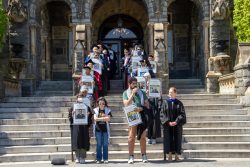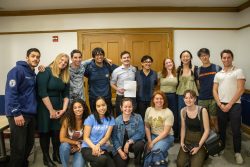University administrators are considering establishing a satellite campus to meet the requirements of the 2010 Campus Plan. This disclosure has not only created concerns about the administration’s willingness to promote student engagement, but also exposed the difficulty the University has experienced fulfilling the requirements of the Campus Plan by 2015.
On July 16, 2012, the D.C. Zoning Commission voted to approve the 2010 Campus Plan. Although the plan took the administration and the neighborhood groups two years to negotiate, it was the first campus plan to be resolved outside of the courts. Even so, no students were present in the negotiations.
The 2010 Campus Plan requires that the administration add 385 new beds by 2015 and house 90 percent of its undergraduate students on campus by 2025. Any new residences must either be built on the main grounds of the University or outside of the 20007 zip code. To meet this requirement, the administration began to draft plans for the expansion of housing on campus.
Administrators considered several options, such as converting the Georgetown University Hotel and Conference Center into a dorm, but they ultimately decided to build an entirely new dorm on the grounds of the so-called Northeast Triangle.
Plans were unveiled in a student forum on July 17, 2013. The Northeast Triangle structure would be located on the northeast side of campus across from the Reiss Science Building. The planned structure sparked a severe backlash from the students who criticized the proposed dorm for its appearance and location.
In response to the criticism, the administration and Sasaki Associates, the firm hired to design the new dorm, redesigned the Northeast Triangle building and presented the new design to students on Aug. 28, 2013. The redesigned structure addressed some student concerns, but the total number of beds the dorm could hold dropped from 250 to 225.
With the 2015 deadline looming, the administration has to find another way to meet the requirements of the Campus Plan.
During the spring of 2013, administrators floated a new idea to meet the requirements of the Campus Plan to small groups of student leaders—an off-campus dorm.
“The first time this came out was in the Facilities and Planning working group in the spring,” said Adam Ramadan (SFS ‘14), the Vice President of GUSA. “Robin Morey [Georgetown’s Vice President of Facilities and Planning] just asked the group about the possibility of an off-campus dorm.”
In several other meetings, student leaders such as Nate Tisa (SFS ‘14), president of GUSA, and Peter Prindiville (SFS ‘14), a member of the Advisory Neighborhood Commission 2E, would continue to hear suggestions about the creation of an off-campus dorm, or “satellite campus,” located in Rosslyn, Glover Park, or near the Capitol.
Student responses to the option of establishing this satellite residence have been mostly negative. Tisa voiced concerns over the administration’s lack of student input on the issue while Prindiville said he believed the creation of the satellite campus would “absolutely change what it means to be a Georgetown undergraduate student.”
Responding to these concerns, the administration held a meeting with student reporters on Monday morning to stress that no concrete plans existed for the creation of a satellite campus.
“It’s really the early stages of thinking about a whole range of options,” said Lauralyn Lee, associate vice president for community engagement and strategic initiatives
These administrators’ assurances, however, did not halt the announcement of the “One Georgetown, One Campus” campaign. Led by Zach Singer (SFS ‘15), chief of staff for GUSA, the campaign began with a press conference to students on Sept. 9.
“It’s time to say no to the satellite campus,” Singer said. “Student voices deserve to be in play because this is going to affect students in the past, present, and future.”
In addition to announcing the start of the “One Georgetown, One Campus” campaign, Singer asked students to sign a petition to introduce a referendum on whether or not students want a satellite dorm. By Sept. 10, the petition collected 412 signatures, more than enough to meet the 300 signatures needed to trigger a student referendum.
Even though several students support the campaign, others see merits in having a satellite dorm.
“These off-campus dwellings offer potential avenues to students who might not already live on campus,” said Craig Cassey (COL ‘15), member of the Advisory Neighborhood Commission. “Why not give them Georgetown affiliated housing with better facilities or amenities as opposed to just leaving them on their own to deal with finding landlords?”
Although the goals of the “One Georgetown, One Campus” campaign are clear, the substance of the discussions on a satellite dorm remain obscure. Tisa and Ramadan have said other options for meeting the requirements of the Campus Plan exist, and administrators have confirmed that they have considered alternatives.
“To date, the University has considered numerous on-campus options of which the preferred sites are Kober Cogan, Harbin Terrace and the Northeast Triangle,” Morey said. “Other options the University has considered are an infill to the Southwest Quad, a small addition to Henle Village, renovations of the East Leavey Tower, addition of a new tower to the Leavey, and new construction on the west end of the McDonough parking lot.”
“One Georgetown, One Campus” supporters, however, are worried about why the University has continued to consider a satellite dorm despite negative student feedback. Tisa and Ramadan suggested that renting a building to house students is financially and logistically easier than constructing new housing.
The administration has $55 million set aside for the expansion of housing. The Northeast Triangle structure is projected to cost between $35 and $40 million, leaving the administration with $15 to $20 million to pay for the additional 160 beds it will need to satisfy the requirements of the Campus Plan.
Finances, however, do not seem to be the main concern of administrators. “Financial considerations are always a factor in any process but are not driving this decision,” Lee said.
Monetary constraints may not be worrying the administration, but the timeline for the construction of the Northeast Triangle building remains in question.
“The Northeast Triangle is supposed to be done in time to alleviate a vast majority of this commitment [the requirements of the 2010 Campus Plan],” Tisa said. “Now partly because of the design problems, they [the administrators] are saying it might not be done in time.”
This time constraint opens the possibility for the University to miss the deadline for the 385 beds by 2015. Tisa and Ramadan, however, see a possible renegotiation with the neighborhood groups as a way to make more opportunities for student involvement.
“Another important part of why we need a student vote … is to put us in a better position to go to the neighbors and tell them why a satellite campus does not solve their problems,” Tisa said.
Extending the deadline, however, would require the approval of the Citizens Association of Georgetown, ANC, and Georgetown University. If the proposal receives approval by these bodies, it would still need to be submitted to the D.C. Zoning Commission, which has the final say.
Tisa and Ramadan still believe that the administration should focus on the long term effects of campus planning for the benefit of the students.
“If the university wants to do right by the student body, a couple million dollars should not be a deterrent for a long term solution like the Northeast Triangle that will hopefully be around for a long time,” Ramadan said. “I think if we’re going to do this, let’s do it right.”




